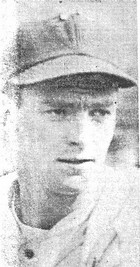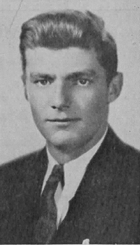Ernie Ford
| Date and Place of Birth: | February 4, 1919 Watertown, MA |
| Date and Place of Death: | May 4, 1945 Corpus Christi, TX |
| Baseball Experience: | Minor League |
| Position: | Pitcher |
| Rank: | First Lieutenant |
| Military Unit: | US Marine Corps |
| Area Served: | Pacific Theater/United States |
Ernest B. Ford, Jr., was a “huge broth of a lad with a heart as big
as his body,” who signed with the Boston Red Sox in May 1942. Ford
graduated from Watertown High School in 1938, and enrolled at the
College of the Holy Cross in Worcester, Massachusetts.
It was the year of the Great New England Hurricane, and his father was
working for the Watertown Fire Department at the time. The hurricane
claimed nearly 700 lives and his father suffered injuries to which he
would succumb on January 2, 1939.
Pitching for the Holy Cross Crusaders in 1940, Ford had a 3–1 won-loss
record and 2.25 ERA. In 1941, due to illness, Ford pitched very little,
making only one start in which he limited Boston College to three hits
in a 13–1 win. In 1942, he returned in style and held the Boston Red Sox
to four hits and one earned run in five innings of the annual exhibition
game. His performance against a major league team created a great deal
of interest among East Coast clubs who vied for his services. “The Red
Sox bid high to get Ernie Ford, the Holy Cross southpaw, for their
Louisville farm,” reported Bill Kling in the Lowell Sun in May 1942. “It
can be taken for granted that the Crusader star ... made the best
possible bargain. He first listened to the offers of Paul Kritchell, who
scouts the New England sector for the Yankees, and the Dodgers’ Heinie
Groh.”
In June 1942, Ford joined the Greensboro Red Sox, champions of the Class
B Piedmont League that year, and was 5–6 with a 3.03 ERA. That was to be
his only year in professional baseball. In October 1942, he enlisted in
the Marines, and was at Quantico, Virginia, where he was commissioned as
an officer in February 1943.
Ford had the chance to play some baseball at Quantico, where his
teammates included major leaguers Ted Lyons and Ike Pearson, but he was
soon serving in the Pacific. Overseas for 18 months, First Lieutenant
Ford was decorated for bravery and suffered a bayonet wound while
fighting the Japanese in the Marshall Islands. He returned to the United
States to recuperate in 1944. Ford transferred to flight duty in late
1944, and began training as a pilot. Due to receive his wings in June
1945, he was killed in a plane crash at Naval Air Station Corpus
Christi, Texas, on May 4, 1945. He was survived by his wife, Cecelia,
and their two children, Michelle Ann, and Roberta Joan, and was buried
at St. Patrick’s Cemetery in Watertown, Massachusetts.
|
Year |
Team |
League |
Class |
G |
IP |
ER |
BB |
SO |
W |
L |
ERA |
| 1942 |
Greensboro |
Piedmont | B | 19 | 95 | 32 | 61 | 57 | 5 | 6 | 3.03 |
Date Added January 29, 2012 Updated May 6, 2014
Baseball's Greatest Sacrifice is associated with Baseball Almanac
Baseball's Greatest Sacrifice is proud to be sponsored by


